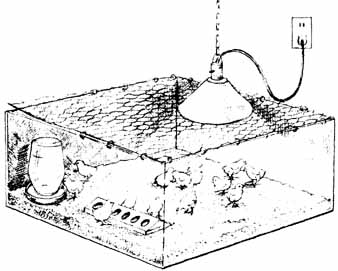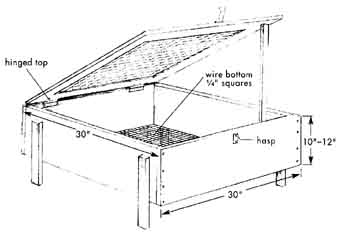When a hen hatches out a brood, she keeps them in the nest until she feels they are ready to venture out into the world. Even after they leave the nest, she keeps them warm and helps them find food. A mother hen gathers her brood under her wings if it rains or she senses danger. She squawks and puffs up, making herself look as big as possible, to chase away any dog, cat, or human that might come near. When you hatch chicks in an incubator, you are responsible for providing them with warmth, food, and protection.
The Brooder Box
Remove newly hatched chicks from the incubator when they are completely dry and fluffy. By that time, they will be scrambling around and complaining loudly. When you open the incubator, you may find some chicks that are still wet. Leave them in the incubator for a few more hours to dry so they won’t get a chill.
Chicks need a warm, dry, draft-free place where they are protected from dogs, cats, and other animals. Such a place is called a brooder. The simplest brooder is a sturdy cardboard box big enough to provide 76 square inches of space per chick.
Fasten a piece of chicken wire to the top of the box so air can get in but pets can’t.
Place a piece of cardboard or some newspapers over part of the top to keep out drafts.
At one end of the box, hang a light bulb in a reflector; you can purchase this setup at a farm store or hardware store. The heat from the light will keep the chicks warm. To increase the warmth level, lower the light or increase the wattage; to decrease the warmth level, reduce the wattage, raise the light, or use a larger box.

A brooder must offer chicks warming light, good ventilation,
clean litter, and plenty of food and water.
Line the bottom of the box with several layers of newspaper topped with paper toweling. The paper toweling gives the chicks better footing than newspaper, which they would find slippery. After a few days, when the chicks are walking and eating well, you can use wood shavings, sand, or other litter at the bottom of the brooder. Litter absorbs droppings and helps keep the chicks warm and dry but should not be used until they learn to eat chick feed instead of litter. Each day, sprinkle a little clean litter over the old litter.
You can tell whether chicks are comfortable in the brooder by the way they act:
• If they are too warm, they will move as far away from the light as they can, crowding into the corners and possibly smothering one another.
• If they are not warm enough, they will complain loudly, crowd under the light, sleep in a pile, and possibly smother one another.
• When they are just right, they will move freely around the brooder, make contented sounds, and sleep nicely spread out.

Too warm; Too cold; Just right
Feeding Chicks
A chick should drink its first water soon after it comes out of the incubator. Clean, fresh water should be available at all times thereafter. The easiest way to water chicks is to use a 1-quart glass jar fitted with a chick watering basin from the farm store or poultry supply catalog. Fill the jar with water, place the basin on top, and flip the jar over Every time a chick rakes a drink, water flows out of the jar into the basin These devices are designed to keep chicks from getting the water dirty by walking in it or falling into the water and drowning As the chicks get older and need more water and a larger basin, switch to the 1-gallon size.
Even though a chick should drink right away, it may not be may not be ready to eat. It is still living on reserves supplied by the yolk it absorbed just before hatching. When you order chicks by mail, they are shipped right out of the incubator. Their yolk reserves let them survive many hours in the mail. By the time they arrive, though, they will be ready for food and water.
Feed chicks a starter ration purchased from the farm store. Starter is higher in protein and lower in calcium than lay ration, which should never be fed to young chickens. Some brands of starter are medicated, some are nor. If you take proper care of your chicks and keep their housing clean and dry, medication is not necessary. Medicated feed is a poor substitute for good management.
In areas where chickens are big business, farm stores sell a variety of rations for chicks. You may find starter ration for newly hatched chicks and grower ration for older chicks. You may find one kind of grower ration for meat birds and another kind for layers. Inmost parts of the United States, though, you will find only one all-purpose starter or starter-grower.
Place the starter ration in a feeder designed especially for chicks. If the feeder has a cover with slots in it, allow one slot per chick. If the feeder is a trough type with out a cover, allow 1 inch of trough length per chick, or half that if the chicks can eat from both sides.
To minimize waste, fill the feeder only two-thirds full. The top of the feeder should be as high as the chicks’ backs. Raise the feeder as the chicks grow, either by using a hanging feeder with an adjustable chain or by f a wooden block to the bottom of the feeder. Once your chicks outgrow their baby feeder, switch to a chicken-sized model.

Chicks shipped by mail fro a supplier wilt arrive packed
tightly in a well-ventilated box. Their yolk reserves allow them to survive
their First hours out of the incubator without food or water.
Feeding Layers versus Broilers
If you are raising layers, when they reach 18 weeks of age, gradually mix more lay ration into the starter until they are completely switched over to adult ration by the time they start laying. Of the laying breeds, each pullet will eat about 25 pounds of feed by laying age at 20 weeks. Dual-purpose breeds take a bit longer to reach laying age and eat about 27 pounds of feed.
If you raise chicks for eggs, you want them to grow slowly so they are fully developed by the time they start to lay. If you raise broilers, on the other hand, you want them to grow as fast as possible to keep them nice and tender until they get big enough to butcher. The younger the chicken, the more tender it will be.
Young birds convert feed into meat more efficiently than older ones. The most economical meat is a broiler or fryer weighing 2½ to 3½ pounds. Raising roasters that weigh 4 to 6 pounds costs more per pound. Feed meat chicks often to stimulate their appetite. The more they eat, the faster they grow.
An efficient broiler eats approximately 2 pounds of starter for every pound of weight it gains. If you raise an efficient meat breed or hybrid to3½ pounds each will eat 7 pounds of starter by the time it is ready to butcher at 7 to 8 weeks. If you raise a dual-purpose breed, your broilers won’t grow as rapidly. Depending on their breed, by the time they weigh 3½ pounds, they may eat twice as much as a specialized meat breed.
Culling: As your chicks grow, oil any that are deformed. Watch especially for runt and chicks with crooked breasts or backs. Deformed chickens do not grow well, may not lay well, cannot be shown, and should not be kept for breeding. Except For runts and diseased birds, culls may be raised for home butchering, if you are so inclined. Otherwise, dispose of culls as they come to your attention.
Health Problems
Different chick diseases prevail in different parts of the United States. Your county Extension agent or state poultry specialist can advise you about the need to vaccinate your chicks. Three common conditions that can affect nearly all chicks are pasting, coccidiosis, and brooder pneumonia.
Pasting occurs when droppings stick to the bird’s rear end and clog the vent opening. Gently pick off the wad of hardened droppings, taking care not to tear the chick’s tender skin. To prevent pasting, make sure that your chicks aren’t getting a chill. If pasting persists, mix a little cornmeal or ground-up raw oatmeal with their starter. By the time your chicks are 1 week old, pasting should no longer be a problem.
Coccidiosis is a parasitic infection that causes droppings to be loose, watery, and sometimes bloody. Chicks raised in the cool weather of early spring are unlikely to get this disease unless they live in filthy conditions or are forced to drink dirty water. Coccidiosis occurs more often during warm humid weather, when the parasites naturally flourish. To prevent this disease, take measures to keep the drinking water free of droppings and scrub the waterer every time you refill it. Keep the brooder lined with clean litter and immediately replace dirty or wet litter.
If you regularly raise chicks, avoid coccidiosis by making or buying a brooder with a wire mesh floor that lets droppings fall below the mesh. Another way to prevent infection with coccidia is to feed medicated starter, which contains a coccidiostat. Medicated feed is designed to be a preventive measure and therefore won’t help chicks that have coccidiosis. Treating the disease requires stronger medication that you can purchase from a farm store, poultry supplier, or veterinarian.

If you plan to raise chicks on a regular basis, a permanent
brooder with a raised floor may be a wise investment to prevent infection
by coccidiosis.
Brooder pneumonia is a fungal infection of the lungs. Affected chicks may have difficulty breathing, or they may just sicken and die. To prevent brooder pneumonia, be sure that the feed and litter are free from molds (fungi).
Keep your chicks warm, dry and away from drafts and predators, feed them properly, and make sure they always have clean water, and chances are good they’ll thrive.
As They Grow
Chicks start growing feathers on their wings within a day or two of hatching. Depending on their breed, they will be fully feathered by the time they are 4 to 6 weeks old. By then, they need at least I square foot of space each and no longer need artificial heat. They are ready to be moved out of the brooder and into the chicken house.
As the chicks grow, be sure to provide less heat and more space. Chicks that are kept too warm or crowded start pecking at one another, causing serious wounds that lead to cannibalism. Cannibalism is a learned habit that usually starts about the time feathers start growing on the lower back. Once cannibalism starts, it’s difficult to stop. Preventive measures include increasing the available space, reducing heat and light, and using a red light bulb that minimizes the attractiveness of blood and emerging blood-filled feathers.
Relieving boredom is another way to prevent cannibalism. Perches help relieve boredom by giving chicks something to play on. Given a chance, chicks will practice perching when only a few days old. Pretty soon, they’ll be playing perching games. A chick may jump onto the perch and then jump off the other side, scaring the dickens out of the other chicks. Or one chick may follow another onto the perch, causing the first to lose its balance and hop down. After a few weeks, some chicks will roost on the perch overnight. By the time they are 4 or 5 weeks old, they will all roost. Allow 4 inches of roosting space per chick.
Don’t use a perch, however, if you’re raising broilers. A perch causes heavy meat birds to get blisters on their breasts. Blisters and calluses may also occur on heavy birds housed on a wire floor or on packed, damp litter. If you raise broilers, forget the perches and freshen the bedding every day.
Chicken Development
Development |
Age in weeks |
Chicks feather out Cockerels crow Pullets start laying |
4-6 6-8 20-24 |
From Chicks to Chickens
As your chicks grow, you will soon be able to tell the cockerels from the pullets. At 3 to 8 weeks of age, depending on the breed, they will develop reddened combs and wattles. Cockerels have larger, more brightly colored combs and wattles than pullets.
Cockerels will develop spurs on their legs. The older a cock gets, the longer his spurs grow. Most hens have tiny spurs or little round knobs in place of spurs. (Game hens are one exception — they may have spurs as long as 1½ inches.)
In some breeds, the cock’s feathers are a different color from the hen’s. In most breeds, the cock’s hackle and saddle feathers are pointed, whereas a hen’s feathers are rounded. The cock also develops long sweeping tail feathers, called sickles.
And, of course, the cockerels are the ones that crow. Their first attempts will sound pretty funny, but soon enough they’ll get the hang of it. When the cockerels start chasing the pullets, it’s time to separate them. Select the best cockerels for breeding and fatten the rest for butchering.
Pullets start laying at 20 to 24 weeks, depending on the breed. The first eggs will be small and probably found on the floor. After a few weeks, you should find regular-sized eggs in the nests.
Next: Chicken Health
Prev.: Hatching Eggs